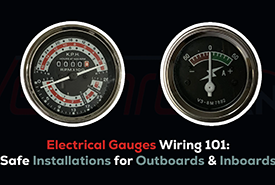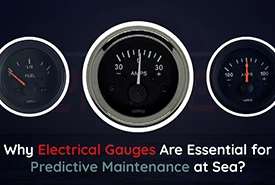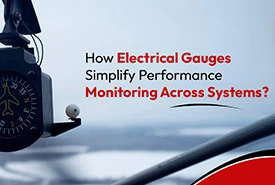- Free shipping for NZ Customers. All items are available in NZ warehouse
- +64 (0) 212576146
- [email protected]
Electrical Gauges Wiring 101: Safe Installations for Outboards & Inboards

Replacement Gauges for Industrial Applications: What You Need to Know
August 15, 2025
Digital Gauges Troubleshooting: Fix Dropouts, Flicker & Sensor Noise
September 10, 2025Wiring Electrical Gauges on a boat isn’t rocket science, but a neat, well-planned install can save you from flickering needles, mystery alarms, and weekend downtime. This guide walks you through best practices for outboards and inboards, so your Electrical Gauges deliver reliable readings and a tidy helm.
Before you start: a quick checklist
- Confirm the gauge type and voltage that match your boat’s system
- Use marine grade tinned copper wire, quality crimp terminals, and heat-shrink
- Plan the route to avoid heat, sharp bends, standing water, and busy RF areas
- Label both ends of every run so future you will say thanks
- Keep a small fuse assortment and spare terminals on hand
If you’re replacing older instruments, skim the manufacturer’s instructions first. Veethree’s pages regularly remind buyers to check compatibility and read the manual for wiring, calibration, and mounting details.
How a typical Electrical Gauge circuit works
Most electrical analog gauges share three paths:
- power from a switched feed, 2) a clean ground, 3) a sender signal. Many Veethree fuel and engine gauges label these posts as I for ignition power, G for ground, and S for sender. Veethree’s wiring sheet and troubleshooting guides illustrate this layout for common marine panels and fuel gauges.
When you’re pairing a gauge with a sender, match the resistance range the gauge expects. Marine fuel systems frequently use 240-to-33-ohm senders, while other vehicles and eras use different curves. Veethree’s sender pages list the available ranges and the 240-to-33-ohm option that most marine owners know.
Step by step: wiring a typical Electrical Gauge
- Disconnect the battery
Kill power before you touch any terminals. - Dry fit the gauge
Check dash cutout and clearance behind the panel. Confirm you can route wires without tight bends or chafe points. - Run the power feed
From a switched source at the helm to the gauge I terminal, with an appropriately sized inline fuse near the source. Group your feeds with loom for a clean run. - Ground the gauge
Bring the gauge G terminal to a clean ground bus. Avoid stacking too many ring terminals on a single stud. - Connect the sender
Run the sender lead to S. For marine fuel systems, the sender lead is commonly pink in standard harnesses and shown that way in Veethree’s fuel gauge diagnostic sheet. - Light the gauge
Connect the lamp circuit per the product instructions, then daisy chain lamp grounds neatly to the bus. Veethree’s panel wiring diagram shows typical light and instrument paths if you want a visual. - Strain relief and protection
Support wires near the gauge with clamps, add drip loops where water could track, and heat-shrink your crimps. - Power up and test
Turn on ignition and verify behavior. If the reading looks wrong, use the quick tests below.
Quick tests that save hours
Veethree’s troubleshooting sheet for 240-to-33-ohm fuel systems lays out two fast checks:
- Key on, unplug the sender wire from S. The gauge should fall below Empty.
- With key on, temporarily jumper S to ground. The gauge should sweep above Full.
If both tests behave, the sender or tank ground is likely the culprit.
Outboards vs inboards: wiring tips
Outboards often bring a factory harness to the dash. Use the provided adapters and follow the engine maker’s trim, tach, and sender signal guidance. Keep harness loops tidy to avoid steering pinch points.
Inboards usually give you more access to engine grounds and sender locations. Keep runs short, secure them off hot manifolds, and avoid sharing high current return paths with sensitive instruments.
For either layout, choose gauges built for marine use. Veethree’s marine and electronic gauge lines are designed for the environment and integrate cleanly at the helm.
Common mistakes with Electrical Gauges
- Mismatched sender and gauge curve
A 10-to-180-ohm sender won’t read correctly on a 240-to-33-ohm fuel gauge. Cross checks the resistance range on Veethree’s sender listings before you wire. - Missing or shared grounds
Daisy chaining grounds without a proper bus can cause drifting readings and dim backlights. - Automotive connectors in a wet helm
Use marine grade terminals and heat-shrink. Keep splices minimal and elevated from the bilge. - No fuse on the feed
Always protect the switched supply for each gauge circuit. - Ignoring the instructions
Product and series differences matter. Veethree’s support hub and instruction sheets cover specifics like connection styles, dropping resistors, and harness options.
Helpful accessories for clean installs
When you need to step down from 24 V to 12 V for a gauge, look for a dedicated dropping resistor or converter specified by the maker. Veethree’s support library includes parts such as dropping resistors and connection information for common connector families. For trim, fuel, and other senders, browse the accessories and compatible parts to round out your install.
When to replace rather than rewire
If your current instruments are corroded, fogging, or the wiring has been hacked over the years, a fresh panel with new instruments can be faster than chasing gremlins. Veethree sells replacement gauges and matching senders for marine applications, and their site has category pages for electronic gauges plus detailed sender listings to ensure compatibility.
Final checks before the first trip
- With the key on, verify each Electrical Gauge powers, lights, and returns to rest with the key off
- Tug test every connection
- Confirm that harnesses clear steering and throttle movement
- Log your sender ranges and wire colors on a label behind the panel
If you want a deeper dive into pairing Electrical gauges with senders, start with Veethree’s fuel sender pages and troubleshooting references, then explore the instruction sheet library for your specific series.
FAQs





